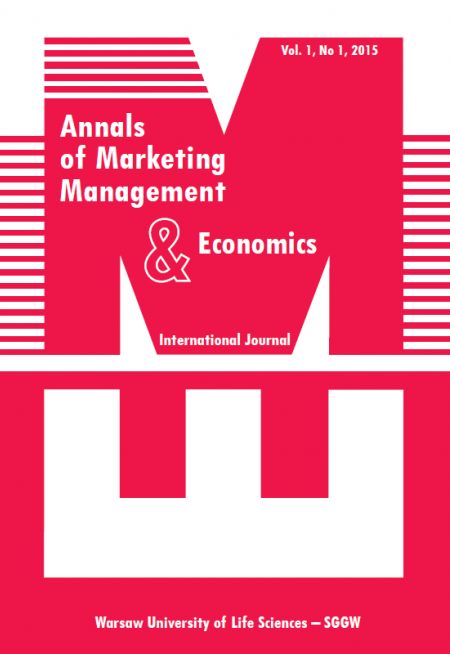Main Article Content
Article Details
Adewale B.A., Ibem E.O., Amole B., Adeboye A.B., 2018. Assessment of residential satisfaction in the core area of Ibadan Metropolis, Nigeria, "Journal of Human Behavior in the Social Environment" 29, 2, 206-233.
American Customer Satisfaction Index (ACSI) Methodology Report (2005), University of Michigan, Ann Arbor.
Andersen E. W., Fornell C., Lehmann D. R., 1994. Customer Satisfaction, Market Share, and Profitability: Findings from Sweden, "Journal of Marketing" 58, 3. https://doi.org/10.1177/002224299405800304
Bitner M.J., Hubbert A.R., 1994. Encounter Satisfaction Versus Overall Satisfaction Versus Quality: The Customer's Voice, (in:) R. T. Rust, R. L. Oliver (eds) Service Quality: New Directions in Theory and Practice, Sage Publications, London, 72-94.
Bohnné Keleti K., 2005. Elégedett az ügyfél? (Satisfied customer?) [in Hungarian], Public Press Kft., Dunaújváros.
Bruhn M., Murmann B., 1998. Nationale Kundenbarometer (National customer barometer) [in German], Springer Fachmedien, Wiesbaden.
Cassel C., Eklöf J., 2001. Modelling customer satisfaction and loyalty on aggregate levels: Experience from the ECSI pilot study, "Total Quality Management" 12, 7-8. https://doi.org/10.1080/09544120100000004
ECSI Technical Committee, 1998. European Customer Satisfaction Index: foundation and structure for harmonized national pilot project. Report prepared for the ECSI Steering Committee.
Fornell C., 1992. A National Customer Satisfaction Barometer: The Swedish Experience, "Journal of Marketing" 56, 1. https://doi.org/10.2307/1252129
Helgesen Ø. Nesset E., Strand Ø., 2013. "Brain Drain" or "Brain Gain"? Students' Loyalty to their Student Town: Field Evidence from Norway, "European Planning Studies" 21, 6, 909-943.
Hofmeister Tóth Á., Simon J., Sajtos L., 2003. A fogyasztói elégedettség (Consumer satisfaction) [in Hungarian], Alinea Kiadó, Budapest.
Horváth A., 2001. A logisztika és a vevőelégedettség kapcsolata. A logisztikai kiszolgálási színvonal vizsgálata (The relationship between logistics and customer satisfaction. Examination of logistics service level) [in Hungarian], Budapesti Közgazdaságtudományi és Államigazgatási Egyetem, Budapest [Ph.D. thesis].
Insch A., Florek M., 2008. A great place to live, work and play, "Journal of Place Management Development" 1., 2., 138-149.
Johnson M., Gustafsson A., Andreassen T., Lervik L., Cha J.,2001. The evolution and future of national customer satisfaction index models, "Journal of Economic Psychology" 22, 2. https://doi.org/10.1016/S0167-4870(01)00030-7
Jorgensen B., Stedman R., 2001. Sense of Place as an attitude: Lakeshore owners attitudes toward their properties, "Journal of environmental Psychology" 21(3). https://doi.org/10.1006/jevp.2001.0226
Kano N., Seraku N., Takahashi F., Tsuji S., 1984. Attractive Quality and Must-Be Quality, "Journal of the Japanese Society for Quality Control" 14(2).
Kenesei Z., Kolos K., 2014. Szolgáltatásmarketing és - menedzsment (Service marketing and management) [in Hungarian], Alinea Kiadó, Budapest.
Lee J., Kyle G., Scott D., 2012. The Mediating Effect of Place Attachment on the Relationship between Festival Satisfaction and Loyalty to the Festival Hosting Destination, "Journal of Travel Research" 51, 6, 754-767.
Lengyel I., 2003. The Pyramid-model. Enhancing Regional Competitiveness in Hungary, "Acta Oeconomica" 2004, 3, 323-343.
Lervik-Olsen L., Johnson M., 2003. Service equity, satisfaction, and loyalty: From transaction-specific to cumulative evaluations, "Journal of Service Research" 5(3). https://doi.org/10.1177/1094670502238914
Marien A., 2016. A lakosság területi identitástudatának magatartási megnyilvánulásai és marketingaspektusai (Behavioral manifestations and marketing aspects of the population's territorial identity) [in Hungarian], Miskolci Egyetem, Miskolc [PhD thesis].
Matzler K., Hinterhuber H. H., 1998. How to make product development projects more successful by integrating Kano's model of customer satisfaction into quality function deployment, "Technovation" 18, 1, 25-38.
Mesch G., Manor O., 1998. Social Ties, Environmental Perception, And Local Attachment, "Environment and Behavior" 30(4). https://doi.org/10.1177/001391659803000405
Mittal V., Ross W. T. Jr., Baldasare P., 1998. The Asymmetric Impact of Negative and Positive Attribute-Level Performance on Overall Satisfaction and Repurchase Intentions, "Journal of Marketing" 62, 1, 33-47.
Peter J.P., Olson J.C., 1987. Consumer behavior. Marketing strategy perspectives, Irwin, Homewood, Illinois.
Sarker M.A.H., Aimin W., Begum S., 2012. Investigating the Impact of Marketing Mix Elements on Tourists, "European Journal of Business and Management" 4, 7, 273-283.
Solomon M., Bamossy G., Askegaard S., Hogg M.K., 2006. Consumer behaviour. Prentice Hall, Pearson Education Limited, Harlow.
Speare A., 1974. Residential satisfaction as an intervening variable in residential mobility, "Demography" 11, 2, 173-188.
Urbánné Treutz Á., 2019. Examination of place identity models, ICOM Conference, Gödöllő, Hungary.
Walden D., Graves S., Walls T., Chapman Wood R., Graham A., Shiba S. (eds.), 1993. Kano's methods for understanding customer-defined quality, Center for Quality of Management Journal 2, 4.
Yuksel A., Yuksel F., Bilim Y., 2010. Destination attachment: Effects on customer satisfaction and cognitive, affective and conative loyalty, "Tourism Management" 31, 2, 274-284.
Zenker S., Petersen S., Aholt A., 2009. Development and Implementation of the Citizen Satisfaction Index (CSI): Four Basic Factors of Citizens' Satisfaction, Universität Hamburg, Hamburg.
https://www.kanomodel.com/discovering-the-kano-model/ [accessed: 2019.08.29].
https://m.theacsi.org/about-acsi/history [accessed: 2019.08.15].
https://m.theacsi.org/about-acsi/the-science-of-customer-satisfaction [accessed: 2019.08.15].
https://medium.com/mito/kano-5714e6d9bab3 [accessed: 2019.08.29].
https://www.van-haaften.nl/customer-satisfaction/customer-satisfactionmodels/61-the-european-customer-satisfaction-index [accessed: 2019.08.26].
Downloads

This work is licensed under a Creative Commons Attribution 4.0 International License.





